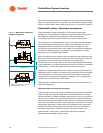
SYS-APM001-EN Chiller System Design and Control
79
System Issues and Challenges
Low T Syndrome
For many years the “low T syndrome” debate has raged.
27, 28
The symptom
of the problem is that, in large systems, return-water temperature is too low,
thus not allowing the chillers to fully load. Many system operators simply turn
on more pumps and chillers to satisfy flow requirements, which wastes energy.
For primary-secondary systems, some system designers advocate putting a
check valve in the bypass line—thus putting chilled-water primary and
secondary pumps in series and varying the flow through chiller evaporators.
Other designers install primary pumps that are larger than necessary and “over
pump” chillers at part-load conditions. These solutions are all “band-aids” and
do not treat the source of the problem. Coad
14
points to the fact that a properly
operating hydraulic system will work as designed and explains the fallacies in
the check valve and over pumping approaches. (Refer to the “Check valves”
sidebar on page 46.) Taylor
29
recommends that a number of mitigating
procedures be implemented to eliminate the problem. They include:
• Eliminating three-way valves
• Ensuring that airside control is not causing the problem
• Properly maintaining the system, including regular air filter changes, coil
cleaning, control calibration, and proper setpoints
Before applying band-aid approaches in an attempt to “fix” symptoms such as
low T syndrome, ensure that the system is operating properly using some or
all of the procedures Taylor
29
discusses. In addition to these procedures, simply
reducing the chilled-water supply temperature will have the effect of raising the
system return-water temperature in systems using two-way valves.
Amount of Fluid in the Loop
Two questions must be answered when determining how much fluid is
necessary to maintain proper chilled-water-system control:
• How fast can the specific chiller respond to changing conditions?
• How fast can the system respond to changing conditions?
The amount of fluid the loop requires to operate properly is related to the larger
of these two answers. Note that both answers describe an amount of time.
Required Volume = Flow Rate × Loop Time
Where:
• Required Volume = the amount of fluid in the coil, pipes, evaporator barrel,
storage tank, etc., in gallons [liters]


















